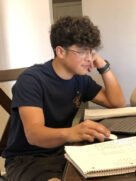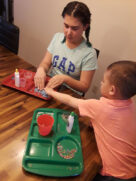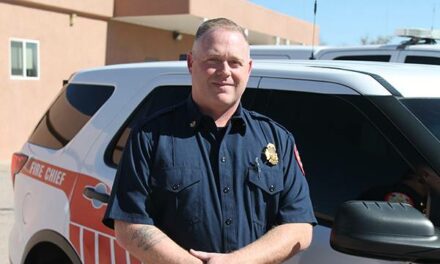
Maverick Vallejos, 4, and his older sister, Belen High School freshman Ceaira Esquibel, 15, wind down their day of lessons with an art project. The two are among the thousands of New Mexico students now learning at home due to the statewide shutdown of schools in response to the COVID-19 pandemic.
As spring blows into the state, thousands of students find themselves learning in a different way due to the coronavirus outbreak.
Here in Valencia County, thousands of students will be learning from home through the end of the school year after the New Mexico Public Education Department made the call to close school sites on Friday, March 27.
Administrators and teachers with the two school districts — Belen Consolidated Schools and Los Lunas Schools — and the School of Dreams Academy charter school are setting up systems and resources to continue education.
PED gave all New Mexico schools until June 15 to give seniors a chance to graduate.
Belen Consolidated Schools
All this week, BCS teachers at all grade levels have been setting up assignments for students. By end of business on Friday, April 3, students will be able to go to the district website — beleneagles.org — to find assignments, said BCS Superintendent Diane Vallejos.
“All of the assignments will be there. Students can use their PowerSchool login to email assignments to teachers directly and ask questions,” Vallejos said. “Teachers will have set officers hours so students can call and get help individually.”
The superintendent said some teachers are using a limited-access social platform called ClassDojo to communicate with students and parents in their classes.
To view assignments and other information from teachers, students need to select their specific school site on the district website, then select “documents” from the menu. Assignments will be posted either by grade level or teacher. The information can also be accessed via the district’s mobile app.
If students have internet access at home, elementary students will be able access to their iStation accounts for reading and math and high school students will still be able to access their work on Edgenuity.
Vallejos said the district is very aware some students don’t have internet access at home or the necessary devices.

Superintendent Diane Vallejos
Belen Consolidated Schools
“We know we have areas with very limited internet access. If students don’t have access at home, we want them to contact their school sites so we can get additional information so we can figure out what will work best for them,” the superintendent said. “We are working with internet providers and any other resources to try to get access to those who don’t have it. We understand many providers are offering free WiFi and discounted rates, but we also know some students just won’t be able to get access.
“That’s why it’s so important for families to communicate with their school. We will provide hard copy lessons but we need to know who and how many we need to provide for.”
Vallejos said the district has a limited number of electronic devices, such as tablets and laptops, for students to check out but they will be issued depending on need.
“One of the things we need to clarify is we don’t have access to funding from sources like HB33 or Educational Technical Notes,” she said. “That has hampered our ability to have these devices available.”
Vallejos said students should expect a call from a teacher at least twice a week; if a student has not been contacted, parents should contact their school site to make sure the correct phone number is on file.
Of the 200-plus seniors this year, Vallejos said the majority are on track to graduate and the district is working closely with those who might be struggling to complete requirements.
Pandemic or not, the state is still requiring seniors to complete 24 credits to get their diploma.
“The state has allowed us to use alternate demonstrations of competency, like it always has,” Vallejos said. “Belen and Infinity teachers and advisors are working directly with seniors and if your student hasn’t received a call yet, contact the school site.”
The superintendent emphasized the alternate demonstrations of competency for seniors was will in place, and included options such as demonstrating applied experience or scores on college entrance exams like the ACTs or SATs, as well as ASVAD scores for entering the armed services.
Both high schools are working to hold some kind of graduation ceremony, she said.
“Each high school will meet with the senior class leadership about a ceremony,” Vallejos said. “We already have a lot of creative ideas.”
The district already has a policy in place that calculates grade point averages of seniors after the third quarter of the year — which was completed before the closure — to determine senior class valedictorians and salutatorians, she said.
“Since we’ve already completed the first three quarters, if a student is failing a course or their grades are low, the course work they get for the fourth quarter can increase that grade and get it where it needs to be,” Vallejos said. “PED has asked schools to go to a pass/fail and we are looking at that closely because we don’t want to diminish anyones GPA.”
Students who might be retained are already known, she said, and there will be continuing conversations about whether the list of students who could possibly be retained would be recommended for retention.
“Those will be done on an individual basis,” the superintendent said.
Looking ahead to next fall, the district anticipates some impact to learning for it’s more than 3,800 students, Vallejos said.
“We usually see some summer regression so we will possibly see some regression due to the closure,” she said. “That’s why it is so important these assignments are completed and students stay in contact with their classroom teacher or adviser; so they can keep their progress moving forward.
“At the beginning of every year, our teachers look to see where kids are and develop lessons from there. We know kids are at all different starting places, like every year but we will bet them up to grade-level standards by the end of the year.”
Vallejos strongly encouraged students and parents to maintain contact with their school sites, to call with questions or concerns.
“It’s important we find out who is struggling so we can get them the support they need. Our counselors and nurses will be available also,” she said. “We understand this is a difficult time. It’s not something any of us anticipated having to do. We’re here and we are working hard. We don’t want parents to feel alone. We need them to reach out to us.”
Los Lunas Schools
Los Lunas Schools Assistant Superintendent Juliette Romero Benavidez, head of curriculum, instruction and accountability, said in regards to elementary education, the school district is curating a special section on its website to serve parents and students.
The page has resources and activities for parents to use during the rest of the school year at home. A few local teachers have also gotten involved and filmed online video lessons for art classes.

Assistant Superintendent Juliette Romero Benavidez
Los Lunas Schools
“We’re building a very robust website right now and it’s all of our core curricular programs,” Benavidez said. “Los Lunas Schools has been very aggressive over the years in our integration of technology and core curriculum, and now we’re very excited we had been because now it’s not a luxury.”
Romero said teachers are communicating with their students daily and the collaboration on student learning is still taking place via technology. She’s seen the Extended Learning Time clubs still meeting online and coaches meeting virtually with their teams.
“Teachers, if they didn’t know how to navigate Zoom before, they definitely do now,” Romero said. “It’s like it’s our new normal, and Zoom can be so much fun and such a great resource for everyone. Right now, because the teachers are working from home, their No. 1 task is to communicate with those families every week.”
Because of the Apex Learning credit recovery curriculum, teachers are focusing on working with those students who are not credit-current.
“Right now, the push is, there shouldn’t be any seniors this semester who don’t pass. The goal is to get everybody to graduation now that we have the time to make those personal connections,” Benavidez said. “In a perfect world, no one would be reclassified but we’re striving to not have that many because students have the time to get that accomplished.”
The total student population at Los Lunas Schools is 8,508. Among the three high schools within the district, there are 539 seniors.
Century High School is still planning its graduation on May 15, and Los Lunas and Valencia High School on May 22. The type of ceremony will be dependent on state mandated requirements.
Los Lunas High School, Valencia High School and Century High School seniors must complete 24 credits based on their 2019-20 Los Lunas Schools course description book and PED minimum requirements.
School of Dreams Academy
School of Dreams Academy Superintendent Mike Ogas said his staff had been anticipating this transition since spring break.
“I don’t think we skipped a beat in terms of being able to provide direction and instruction,” Ogas said. “I think we were more prepared than most.”

Superintendent Mike Ogas
School of Dreams Academy
News-Bulletin file photo
The school had already been moving in the direction of Google Classrooms and online learning. There are currently 42 seniors at SODA who have been briefed on what their requirements will be to graduate.
“We started to brainstorm different ways if we needed to on graduation itself. They’re all thinking about it and talking about it and we’ll be meeting with them weekly,” Ogas said.
A virtual ceremony and a delayed autumn ceremony are two of the options staff and seniors are discussing as possibilities for graduation, depending on the mandated restrictions set in place by the state at that time.
“It’s kind of like a work in progress,” Ogas said. “I’m very impressed with how they’ve handled it and I’m very impressed with how our staff is handling this.”
Staff has been meeting with parents and students at all levels via Zoom. Individualized education plans and video conferences have also been held online.
As for students who don’t have access to the internet, they have been receiving work packets and phone calls from staff to check on them.
“We’re really following strongly the guidelines that are being presented to us to make sure we’re caring for the social and emotional needs of our students and families, not worrying so much about inundating them with work,” Ogas said.
“We’re seeing if they need any assistance, even access to counseling or just utilizing Zoom to let kids connect with each other on a social basis.”
Ogas is hoping to have everything fully implemented online by Monday.
Seniors, parents, teachers
Two local senior student athletes used the same word to describe the announcement that public schools were shut down for the rest of the year.
Both Belen High School senior Luke Aragon and Los Lunas High senior Kade Benavidez, who happen to be cousins, said they were initially shocked at the news.
“It’s unbelievable,” said Aragon. “All of this doesn’t seem real. I know it breaks the heart of every senior out there. This is our last year — a key experience in our life and we won’t be able to live through it.”

Los Lunas High School senior Kade Benavidez FaceTimes with friends as he works on an assignment from home.
Submitted photo
Benavidez said the shock came from the unprecedented nature of the statewide closure.
“Something like this has never happened before. It’s a big deal,” Benavidez said. “I’ve kind of already moved past it. I’m just not one of those people that dwells in the past.”
Aragon, the starting quarterback for the Eagles as well as pitcher and infielder, said since he hasn’t been able to play ball this spring, he’s working out in his garage at home.
“I’ve been getting school work done, trying to stay as normal as possible,” he said. “I FaceTime with friends, checking in and seeing how they are doing. Video games are helping, too; playing them and staying in contact with people.”
Benavidez, a Los Lunas Tiger quarterback and pitcher, is keeping up with friends also, in addition to helping his dad several hours a day with yard work and putting in practice at a friends batting cage and doing bull pen workouts.
He recently committed to New Mexico Junior College in Hobbs to play baseball and is staying in condition as much as possible.
“I committed a couple weeks ago. For some other seniors, this season was their last opportunity to get seen,” Benavidez said. “I plan to play baseball in Hobbs for two years, then possibly transfer to a four-year school and play ball and continue my academic career.”
Benavidez plans to get his degree in mechanical or computer engineering.
Plans for Aragon are still on track to go to The University of New Mexico and major in business. Aragon said he decided to focus on his academics in college and won’t be playing baseball.

Belen High School Senior Luke Aragon works on his International Festival project from home.
Submitted photo
One Belen parent says the key to keeping her daughter and son on track with their school work while everyone is at home is having a designated time for all the time in the day.
“Even recess. We wake up and get ready exactly like we would if we were heading out the door,” said RaeCee Vallejos.
After breakfast, they are dressed and ready to go nowhere at all. With the governor’s stay-at-home in place, Vallejos and her two children — Ceaira, 15, and Maverick, 4 — are now using home as a place for work, education and recreation, while her husband, Jeremy, works on the road as an electrician doing power installation for large facilities.
“It was a learning curve because they are two very different age groups and learning styles. My son is a hands-on learner and you really have to stay engaged with him,” Vallejos says.
Her daughter is more self-motivated, but has a tendency to focus on what she enjoys rather than what’s on the schedule.

Belen High School freshman Ceaira Esquibel, 15, and her younger brother, Maverick Vallejos, 4, and create an art project together.
Submitted photo
“It’s balancing attention to each of them and giving them what they need,” she said.
Vallejos is also balancing her children’s educational needs with her own job now. As the administrative assistant to Belen Consolidated Schools Superintendent Diane Vallejos — no relation — she is often the first voice people hear when they reach out to the superintendent.
“I’m working a modified schedule where I’m in the office two days a week and have the opportunity to work from home the rest,” she said.
Vallejos said she created a schedule for the household and put it on the refrigerator so expectations are clear on what they will accomplish in a day. There’s reading and math, as well as backyard botany, science projects and art.
When the school and work day are done, Vallejos, Ceaira and Maverick transition to “coming home from work,” by putting away work, cooking dinner and changing into comfortable clothes.
“It’s about keeping those two things separate conceptually even though it’s in the same environment,” she said.
Vallejos said it helps her and her family to focus on the big picture of what they are trying to do as a family and a community.
“We all have to come together for the wellness of everyone,” she said. “And take time for yourself. Just because you’re in the house, supporting your children’s education in a new way, don’t forget to take time for yourself.”
Belen photographer Jessica Aragon agreed that having a routine is important. Even though mornings aren’t quite so early right now, her youngest two — daughter Alyssabrook and son Jesse — are in bed by 9 p.m.
“I get up at my regular time, between 5:30 and 6 a.m. and make sure they’re all up by 8 a.m.,” Aragon said. “We’re trying not to let this effect us in a negative way.”
PED’s recommended guidelines for daily student instruction:• Pre-K : 30 minutes
• Grades K-1: 45 minutes
• Grades 2-3: 60 minutes
• Grades 4-5: 90 minutes
• Grades 6-12: 30 minutes per teacher (3 hours max in a day)
Additional reading time or storytelling is always encouraged.
After everyone has showered, dressed and had breakfast, it’s time to begin school work and other assignments.
“Luke, my oldest, just finished an essay for one of his college credit classes,” she said. “Alyssa is getting packets from St. Mary’s and Jesse is getting his work online.
“The boys will go into the garage and work out with weights. They both play baseball and are keeping up their conditioning. We talk to them, remind them nothing lasts forever.”
While the coronavirus and the self isolation won’t last forever, Aragon is acutely aware of what Luke and his classmates have lost in 2020.
“All these kids have worked so hard for this day, to walk the line and celebrate,” she said. “It’s just sad, really sad.
“One positive we have found in all this is we’ve been able to sit at the dinner table together as a family. That isn’t something we’ve really been able to do with everyone going every which way.”
Dennis Chavez Elementary second grade teacher Carolyn Serafin-Abeyta said her initial reaction to the closure was devastation.
“And I think I speak for the majority of us. We’ve missed being at work, missed our students. We said goodbye for spring break and while many of us were excited about it, we were looking forward to going back to work,” Serafin-Abeyta said. “Then we heard it was extended and then not going back at all was a real gut punch.
Teachers are contacting parents to help them through the transition of helping their children learn from home, but Serafin-Abeyta can see inequities on the horizon.
“Not all our parents have smartphones or computers at home. Internet is notoriously bad in Los Chavez,” she said. “When all the kids are in school, we have equity. When they are not able to pick up the packets or they don’t have a computer or internet, that’s when we have problems. I think this is all going to boil down to socio-economic inequity.”
Teachers are collaborating to create work packets online and for hardcopy delivery to students that will deliver common core standards, Serafin-Abeyta said.
“These packets will include instructions on how to deliver these lessons to students,” she said. “We are making every effort we can; we’ve delivered packets by bus, teachers have delivered these to homes to people who can’t quite get out. We are making every effort we can. We miss our kids.”
Julia M. Dendinger began working at the VCNB in 2006. She covers Valencia County government, Belen Consolidated Schools and the village of Bosque Farms. She is a member of the Society of Professional Journalists Rio Grande chapter’s board of directors.















